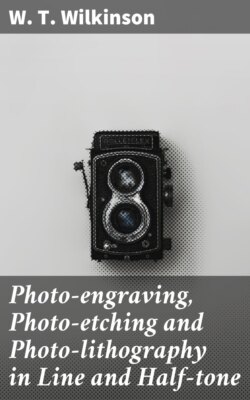Читать книгу Photo-engraving, Photo-etching and Photo-lithography in Line and Half-tone - W. T. Wilkinson - Страница 4
На сайте Литреса книга снята с продажи.
ОглавлениеPHOTO-ENGRAVING, ETCHING, AND LITHOGRAPHY.
PART I. PHOTO-ENGRAVING IN LINE.
Table of Contents
CHAPTER I. APPLIANCES FOR MAKING PHOTOGRAPHIC NEGATIVES.
Table of Contents
For all methods of heliographic printing a suitable photographic negative is absolutely necessary, and to produce that negative good apparatus and pure chemicals, used with skill and intelligence, are indispensable.
The studio must be well lighted, with a perfectly firm floor. The dark-room should be kept for negative work only (the room where the zinc printing is carried on being a separate room). There must be a roomy sink in front of a good-sized window covered with a non-actinic medium (yellow, not orange), such as two thicknesses of golden fabric, so as to have plenty of light to see the progress of development by.
The copying camera must have a long bellows and should not be less than 12 by 10, fitted with rack-work, so as to be able to get absolute sharpness in focussing.
It will be a great advantage, and aid in adjusting the position on the focussing screen of the drawings to be copied, if a vertical line be drawn, and another horizontally, so that they bisect each other exactly in the centre; then from the centre, mark and number each inch and half inch upon each of the four arms of the cross; it can then be seen at a glance not only that the picture is in the centre, but also that it is about the right size. {10}
The dark slide must be light-tight, and made strong rather than for portability.
The lens should be rectilinear, and should be capable of covering the largest size plate the camera will take quite sharp to the corners. For a 12 by 10 plate a lens with an equivalent focus of about 18 inches will be best.
Fig. 1.
To the lens must be fitted a reversing mirror of silvered glass, mounted behind the lens by preference, as such a style of mounting not only protects the surface of the mirror from the air, but keeps extraneous light from affecting the brilliancy of the image. (Fig. 1.)
The camera must be mounted upon a solid table fixed upon small grooved or flanged wheels, such wheels running either upon rails fixed upon or in grooves cut into the floor, at right angles to the wall against which the copying board is fitted.
The copying easel is placed perpendicularly in front of, and perfectly parallel with, the camera. As a mirror is used, the camera is sideways to the object, not facing it, as in copying direct.
The easel should be so contrived that it can be raised or lowered, and moved right and left, which double motion is managed by having the easel double; the up and down motion should be obtained by hanging the back portion like a window sash, the weights being exactly the weight of the whole easel, and the pulleys over which the cords go, not running too freely.
At the top and bottom of the back portions of the easel are projecting strips with a rabbet deep enough to allow the front or copying board to slide sideways, but not loosely; this front board should be painted a dead black with white lines in the centre from top to bottom and from side to side, said lines being divided into inches and half inches, from the centre, so that the drawing may be pinned in the exact centre without trouble.
A convenient size for a copying board is 4 feet high by 5 feet wide.
In connection with the camera, the only thing left to describe is the focussing cloth, which should be quite opaque, and of ample size to exclude all extraneous light from behind when focussing.
For focussing the image absolutely sharp, a magnifying glass may be required.
